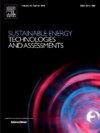Multi-source data-based hydrogen refuelling station location optimization – A case study of Guangdong, China
IF 7
2区 工程技术
Q1 ENERGY & FUELS
Sustainable Energy Technologies and Assessments
Pub Date : 2025-06-28
DOI:10.1016/j.seta.2025.104426
引用次数: 0
Abstract
Hydrogen is a promising alternative to fossil fuels in transportation; however, a significant gap remains between the current number of hydrogen refuelling stations and development targets, due to challenges in optimizing station locations, accurately forecasting demand patterns, and minimizing transportation costs. This study develops an integrated economy-society-infrastructure assessment framework, combining economic, social, and infrastructural factors, to enhance hydrogen station siting. A simulated annealing-based Maximal Covering Location Problem (MCLP) model is used to identify optimal strategies for new, oil-hydrogen combined, and hybrid stations. Additionally, a machine learning approach combining random forest and SVM forecasts hydrogen demand and station locations for 2030 and 2050. Findings indicate that, as of 2023, stations are concentrated in central Guangdong, but by 2030, demand extends to northern, western, and eastern clusters due to shifts in passenger vehicle use. Oil-hydrogen combined stations are the most cost-efficient, reducing costs by 17.2% to 18.5% compared to other strategies. However, average transport costs per station increase from $0.33 million in 2023 to $0.80 million in 2050, highlighting the need for early expansion of hydrogen production facilities to control future transportation costs.
基于多源数据的加氢站选址优化——以广东省加氢站为例
氢是一种很有前途的运输化石燃料替代品;然而,由于优化加氢站位置、准确预测需求模式和最小化运输成本等方面的挑战,目前加氢站的数量与发展目标之间仍然存在很大差距。本研究结合经济、社会和基础设施因素,建立经济、社会和基础设施综合评估框架,以加强加氢站选址。采用基于模拟退火的最大覆盖定位问题(MCLP)模型对新建站、油氢联合站和混合站的优化策略进行了识别。此外,结合随机森林和支持向量机的机器学习方法预测了2030年和2050年的氢气需求和氢气站位置。研究结果表明,截至2023年,站点集中在广东中部,但到2030年,由于乘用车使用的转变,需求扩展到北部,西部和东部集群。油氢联合站是最具成本效益的,与其他策略相比,成本降低了17.2%至18.5%。然而,每个加氢站的平均运输成本从2023年的33万美元增加到2050年的80万美元,这凸显了早期扩建氢气生产设施以控制未来运输成本的必要性。
本文章由计算机程序翻译,如有差异,请以英文原文为准。
求助全文
约1分钟内获得全文
求助全文
来源期刊

Sustainable Energy Technologies and Assessments
Energy-Renewable Energy, Sustainability and the Environment
CiteScore
12.70
自引率
12.50%
发文量
1091
期刊介绍:
Encouraging a transition to a sustainable energy future is imperative for our world. Technologies that enable this shift in various sectors like transportation, heating, and power systems are of utmost importance. Sustainable Energy Technologies and Assessments welcomes papers focusing on a range of aspects and levels of technological advancements in energy generation and utilization. The aim is to reduce the negative environmental impact associated with energy production and consumption, spanning from laboratory experiments to real-world applications in the commercial sector.
 求助内容:
求助内容: 应助结果提醒方式:
应助结果提醒方式:


